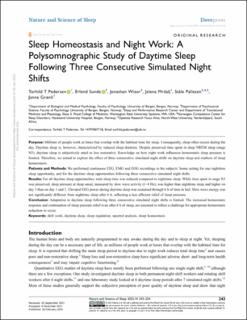| dc.contributor.author | Pedersen, Torhild Thue | |
| dc.contributor.author | Sunde, Erlend | |
| dc.contributor.author | Wisor, Jonathan P. | |
| dc.contributor.author | Mrdalj, Jelena | |
| dc.contributor.author | Pallesen, Ståle | |
| dc.contributor.author | Grønli, Janne | |
| dc.date.accessioned | 2023-02-14T13:26:55Z | |
| dc.date.available | 2023-02-14T13:26:55Z | |
| dc.date.created | 2022-02-22T15:16:16Z | |
| dc.date.issued | 2022 | |
| dc.identifier.issn | 1179-1608 | |
| dc.identifier.uri | https://hdl.handle.net/11250/3050759 | |
| dc.description.abstract | Purpose: Millions of people work at times that overlap with the habitual time for sleep. Consequently, sleep often occurs during the day. Daytime sleep is, however, characterized by reduced sleep duration. Despite preserved time spent in deep NREM sleep (stage N3), daytime sleep is subjectively rated as less restorative. Knowledge on how night work influences homeostatic sleep pressure is limited. Therefore, we aimed to explore the effect of three consecutive simulated night shifts on daytime sleep and markers of sleep homeostasis.
Patients and Methods: We performed continuous EEG, EMG and EOG recordings in the subjects’ home setting for one nighttime sleep opportunity, and for the daytime sleep opportunities following three consecutive simulated night shifts.
Results: For all daytime sleep opportunities, total sleep time was reduced compared to nighttime sleep. While time spent in stage N3 was preserved, sleep pressure at sleep onset, measured by slow wave activity (1– 4 Hz), was higher than nighttime sleep and higher on day 3 than on day 1 and 2. Elevated EEG power during daytime sleep was sustained through 6 h of time in bed. Slow wave energy was not significantly different from nighttime sleep after 6 h, reflecting a less efficient relief of sleep pressure.
Conclusion: Adaptation to daytime sleep following three consecutive simulated night shifts is limited. The increased homeostatic response and continuation of sleep pressure relief even after 6 h of sleep, are assumed to reflect a challenge for appropriate homeostatic reduction to occur. | en_US |
| dc.language.iso | eng | en_US |
| dc.publisher | DovePress | en_US |
| dc.rights | Navngivelse-Ikkekommersiell 4.0 Internasjonal | * |
| dc.rights.uri | http://creativecommons.org/licenses/by-nc/4.0/deed.no | * |
| dc.title | Sleep homeostasis and night work: a polysomnographic study of daytime sleep following three consecutive simulated night shifts | en_US |
| dc.type | Journal article | en_US |
| dc.type | Peer reviewed | en_US |
| dc.description.version | publishedVersion | en_US |
| dc.rights.holder | Copyright 2022 The Author(s) | en_US |
| cristin.ispublished | true | |
| cristin.fulltext | original | |
| cristin.qualitycode | 1 | |
| dc.identifier.doi | 10.2147/NSS.S339639 | |
| dc.identifier.cristin | 2004573 | |
| dc.source.journal | Nature and Science of Sleep | en_US |
| dc.source.pagenumber | 243-254 | en_US |
| dc.identifier.citation | Nature and Science of Sleep. 2022, 14, 243-254. | en_US |
| dc.source.volume | 14 | en_US |

